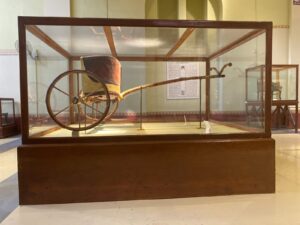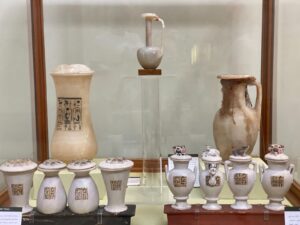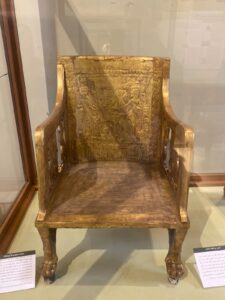In a first-floor hall at the Egyptian Museum in Tahrir, downtown Cairo, are the treasures from the tomb of a royal couple, Yuya and Thuya, whose gilt masks greet visitors at the entrance.
What is the story of the tomb said to be the richest ever discovered in the Valley of Kings before Tutankhamun’s treasures first saw the light of day?
It was in December 1904, during seasonal excavations by the Egyptian Department of Antiquities, sponsored by American lawyer Theodore Davis, that the team found a mound of rock fragments, untouched for a long time and most probably the debris from two previously finds: Tomb KV 3 from the reign of Ramses III and Tomb KV 4 of Ramses XI.
The team dug a trench through the mound and, two months later, they gained access to the tomb, which dates back to about 1400 BC, containing the remains of the parents of Queen Tiye, Pharaoh Amenhotep III’s wife and the grandparents of Pharaoh Akhenaton.
All the objects were packed together in a single chamber, roughly hewn in the limestone, and without decoration or inscriptions. The chamber was approached by a steep stairway, followed by a sloping passage and a second stairway. The entrance to the chamber was closed by a wall of rubble, smeared over with mud bearing the impression of the official seal of the Theban Necropolis, nine kneeling captives surmounted by Anubis.
However, the tomb had been robbed through a hole in the corner of the wall, and the coffins had been disturbed. The robbers probably ransacked the tomb shortly after it had been sealed and subsequently covered up the hole through which they had entered.
When the second sealed door in the tomb was opened, the candlelight revealed a bewildering medley of tomb furniture in considerable disarray. Although the tomb had been entered by a robber shortly after the burials, seemingly only valuable oils, small objects, and fine linen were taken, and once resealed after perhaps one or two additional robberies no later than the 20th Dynasty, it remained intact with little or no air or dust.
The silver leaf was still bright and shiny, and the contents of the vessels were still almost liquid. Aside from Yuya’s light chariot in a far corner of the room, furniture in the tomb included three exquisite wooden chairs. The largest belonged to Satamun, granddaughter of Yuya and Thuya. Elaborate inlaid and gilded wooden chests on legs held jewellery and clothing. A ventilated papyrus box probably held fine fabrics. The three beds, one black, two with silvered or gilded decoration, were fitted with soft mattresses.
The names of the royal couple appear on several objects from the tomb as well as the name of one of their daughters, Princess Satamon. Yuya came from the town of Akhmim in Sohag, where he was a priest of the Min, the chief god of the area.
His wife Thuya was a lover of the gods Amun and Min, and she used the title of ‘Royal Mother of the Great Wife of Pharaoh’.
The two masks on display at the entrance to the gallery protected the heads of the deceased. Yuya’s mask has a long wig. The eyebrows and eyes are inlaid with blue glass. He wears an elaborate collar that extends beneath his wig.
The exact portrayal of Yuya’s facial features made it possible for his soul to recognise him and return to his mummified body, thus ensuring his resurrection.
For Thuya’s mask, the wig consists of long striated hair passing behind the ears tied with a floral band. She wears a broad collar with several rows of inlays.
This mask was discovered broken into two pieces, and was restored in 1982. At that time, the restorer partially removed the linen gauze originally glued to the mask, exposing the marvellous face of this lady with her exquisite smile, enlivened by eyes inlaid with blue glass and quartz with touches of red.
Objects used in daily life are on display. Yuya’s chariot and furniture collection of beds, chairs and gilded wooden boxes inlaid with faience, ivory and ebony as well as canopic vases, amulets and armchairs with openwork design.
The cadavers of Yuya and Thuya were found in their coffins and are well preserved due to the high quality of mummification.
Also on display is Yuya’s 19-metre papyrus bearing illuminated hieratic texts from the Book of the Dead, which would have been hung in the corridor to his tomb.
The ancient elite wore a wide variety of footwear, from the most basic sandals to richly decorated shoes. Here you can see examples of sandals made of gold, plaited grass and reeds.
They could have been worn in life but since they were placed in a tomb, they were to be worn in the afterlife.
The Egyptian Museum in Tahrir is open daily from 9 a.m. until 7 p.m. and tickets will be on sale until 6 p.m.









Discussion about this post